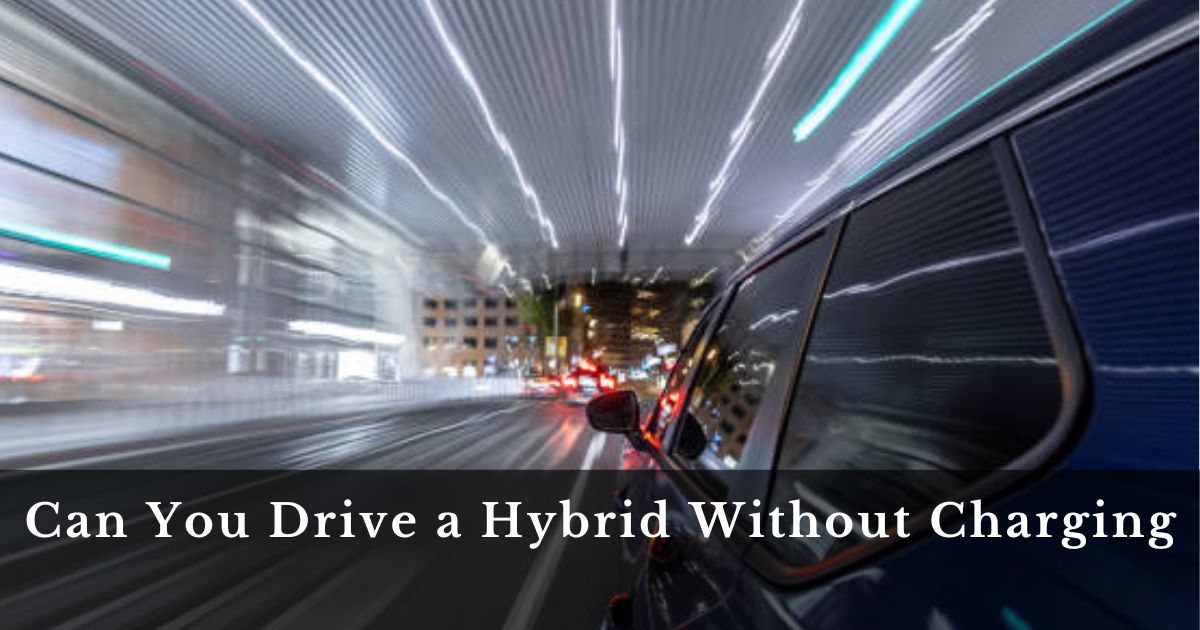Nowadays, people care more about the environment, so hybrid cars are getting more popular. Hybrids use both gasoline and electricity, which helps them use less fuel and produce fewer harmful gases. But many people wonder if you have to charge a hybrid like you do an electric car. Let’s find out: Can you drive a hybrid without charging it up?
Can You Drive a Hybrid Without Charging?
Hybrid vehicles have become increasingly popular due to their environmentally friendly nature and fuel efficiency. However, there is often confusion surrounding whether you can drive a hybrid without charging it. Let’s delve into this topic and uncover the truth behind driving a hybrid without charging.
Hybrid vehicles have revolutionized the automotive industry by offering a blend of fuel efficiency and eco-friendliness. But can you drive a hybrid without charging it? The answer lies in understanding the different types of hybrid vehicles and their operational mechanisms.
Before we delve into the specifics, let’s have a brief overview of hybrid vehicles. Unlike traditional gasoline-powered cars, hybrids utilize both an internal combustion engine and an electric motor to power the vehicle. This dual propulsion system enables hybrids to achieve better fuel economy and reduce emissions compared to conventional vehicles.
How Hybrid Vehicles Work
Hybrid vehicles operate on the principle of synergy between an internal combustion engine and an electric motor. When driving, the vehicle’s onboard computer system determines the most efficient power source based on driving conditions and demand. This seamless transition between the engine and electric motor optimizes fuel efficiency and minimizes emissions.
Explanation of Hybrid Technology
Hybrid technology encompasses various components, including regenerative braking, electric batteries, and sophisticated control systems. Regenerative braking allows hybrids to capture and store energy during deceleration, which is then used to recharge the electric battery. This process enhances overall energy efficiency and reduces the need for external charging.
Different Types of Hybrid Vehicles
Hybrid vehicles come in different configurations, ranging from mild hybrids to plug-in hybrids. Mild hybrids primarily rely on the internal combustion engine for propulsion, with the electric motor providing supplemental power during acceleration. On the other hand, plug-in hybrids feature larger batteries that can be charged externally, offering extended electric-only driving range.
Charging vs. Non-Charging Hybrids
The distinction between charging and non-charging hybrids lies in their reliance on external power sources to recharge the electric battery.
What is a Charging Hybrid?
A charging hybrid, also known as a plug-in hybrid, features a larger battery pack that can be charged using an external power source, such as a wall outlet or charging station. This allows drivers to replenish the battery’s charge and maximize electric-only driving range.
What is a Non-Charging Hybrid?
A non-charging hybrid, often referred to as a self-charging hybrid, does not require external charging as it relies on regenerative braking and the internal combustion engine to recharge the battery. These hybrid without charging utilize energy generated during driving to sustain the electric motor’s operation, eliminating the need for frequent charging.
Driving a Non-Charging Hybrid
Driving a non-charging hybrid is similar to operating a conventional gasoline-powered vehicle, with the added benefit of improved fuel efficiency and reduced emissions.
Fuel Efficiency and Range
Non-charging hybrids offer impressive fuel economy, especially in stop-and-go city driving where regenerative braking can effectively recharge the battery. While their electric-only range is limited compared to plug-in hybrids, non-charging hybrids excel in providing seamless transitions between electric and gasoline propulsion.
Battery Regeneration through Braking
One of the key features of non-charging hybrids is regenerative braking, which converts kinetic energy into electrical energy during deceleration. This process helps replenish the battery’s charge and ensures optimal performance without the need for external charging.
Benefits of Non-Charging Hybrids
Non-charging hybrids offer several advantages over traditional gasoline-powered vehicles and even charging hybrids.
Environmental Impact
By reducing reliance on fossil fuels and minimizing emissions, non-charging hybrids contribute to environmental conservation and help combat climate change. Their efficient use of energy translates to lower greenhouse gas emissions and cleaner air quality.
Cost Savings
With lower fuel consumption and reduced maintenance requirements, non-charging hybrids offer significant cost savings over the long term. While they may have a higher upfront cost compared to conventional vehicles, the savings on fuel and maintenance expenses make them a financially viable option for environmentally conscious consumers.
Limitations of Non-Charging Hybrids
Despite their numerous benefits, non-charging hybrids have certain limitations that need to be considered before making a purchase decision.
Dependency on Fuel
Non-charging hybrids still rely on gasoline as a primary fuel source, which means they are not entirely emissions. While they offer better fuel efficiency compared to conventional vehicles, they are not suitable for drivers seeking a zero-emission transportation solution.
Limited Electric-Only Range
Unlike plug-in hybrids, non-charging hybrids have a limited electric-only range due to their smaller battery capacity. This means that they cannot operate solely on electric power for extended periods, especially during highway driving where higher speeds consume more energy.
In conclusion, driving a hybrid without charging is indeed possible, thanks to the innovative technology and energy-efficient design of non-charging hybrids. These vehicles offer a practical solution for environmentally conscious drivers seeking to reduce their carbon footprint without compromising on performance or convenience.



